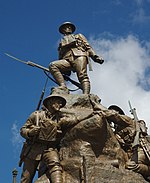Oldham bus station
Buildings and structures in OldhamBus stations in Greater ManchesterUse British English from December 2016

Oldham bus station is a bus station located in the town of Oldham in Greater Manchester. The bus station is found on Cheapside at the junction of West Street. The bus station opened in January 2001 and replaced the previous bus station at Town Square and the bus stops on Cheapside and West Street. The bus station is run by Transport for Greater Manchester.
Excerpt from the Wikipedia article Oldham bus station (License: CC BY-SA 3.0, Authors, Images).Oldham bus station
Priest Hill,
Geographical coordinates (GPS) Address External links Nearby Places Show on map
Geographical coordinates (GPS)
| Latitude | Longitude |
|---|---|
| N 53.5431 ° | E -2.1162 ° |
Address
Oldham Bus Station
Priest Hill
OL1 1NQ , Coldhurst
England, United Kingdom
Open on Google Maps







